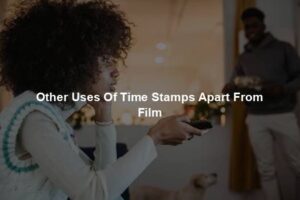
What is Time-coding in Film-Making?
Time-code is a reference number given to a specific point in time within a media file. They’re added to film/video in order to facilitate logging, file organizing, and make searching for specific elements more simple.
- Timestamps are more often used to match up transcription text with a specific scene. This makes the job a lot easier for the editors to locate segments they want to edit during post-production. Timestamps are placed based on the frequency requested by clients.
What Does Time-Coding Involve?
- Time-coded transcripts are written with time-codes, thus allowing the end-user to locate the desired audio or video within the source media instantly. Using time-codes saves money, time, and resources. For searching through long media files for keywords and phrases, this allows the user to identify the location of critical aspects in their media. It increases overall efficiency and allows audio & video producers and editors to improve their workflow.
- Timestamping, spotting, or time-coding involve inserting the time in hours, minutes, or seconds into a transcript at the necessary intervals. It works as a marker of where the particular text can be found in the audio or video. Some transcripts are stamped every five minutes while others are stamped every few seconds! This helps in the process of identification, editing, and subsequent synchronization. It is useful when captioning or subtitling is required for a video. It acts as a pointer to some particular scene as well.
- Time-coding being a special feature is commonly utilized by law enforcement, legal, human resource, and government bodies for hearings, tribunals, witness statements, and evidence interviews. These transcriptions while being used for purposes of legal significance, duly time-stamped, assist judicial action.
Where and why are time-codes used in film?
- Have you ever wondered how filmmakers and video production editors can take hours of video content and condense it down to a 3-minute clip in such a short period of time? Well, it’s likely that they use video-to-text transcriptions that include timestamps to help expedite the process.
- Search engines can’t tell much about your video aside from the title and tags that you provide when you upload it. By having your video transcribed and time-coded, and uploading that transcript to video sites, you’re giving Search engines specific information about the content of your video. When someone searches for a phrase mentioned in the video, Search engines will be able to include your video in the search results, and may even start the video playing at the time-code where that search phrase is used.
What is the importance of timestamps and time-codes in video production?
- Timestamps are often cited as the most important tool in a transcription for video editors and videographers. It helps in the process of identification, editing, and subsequent synchronization. Time-coding feature assists when captioning or subtitling needs to be provided for a video. Having a time-code for a video can also help to review and select the desired scene.
- A researcher can use timestamps to help them jump to a specific point in an audio file so that they can listen to an interviewer’s tone. Was the comment sarcastic? Was the sentence stated as fact? Often you can only tell through intonation in the voice. Using a timestamp speeds up the location process and allows the researcher to accurately understand what was said.
- In legal dispositions, timestamps can also be useful when needing to refer to a specific part of transcription. For example, an individual could use this citation during a hearing: “At [00:15:16] they saw something. This enables anyone to quickly find the reference point stated in both the transcript and the audio file and listen to exactly what the interviewee said.
- Timestamps can also be used when neither you or the transcription service provider can make out what the speaker is saying in the audio or video recording. When this situation occurs, it is common practice to type the word ‘inaudible’ and include the timestamp. For example: ‘We use hops and [inaudible 00:17:23] in our brewing process’.
What is the importance of time-codes to transcriptionists?
Time-codes for a video must be frame-accurate so adding the frames or milliseconds are important. This element is commonly used for subtitles, and video captions but it has other uses as well. Transcriptionists and editors greatly benefit from these time-codes as it allows them to use particular scenarios more easily and accurately synchronize subtitles with each scene.
- To identify uncertain spelling. There are lots of English words that sound similar so distinguishing them from each other can be difficult. The same goes for similar-sounding names that are spelled differently. This certain type of time-code can be used if the transcriber isn’t sure of a particular word’s spelling. An example of this is shown below. E.g. I met with [ Stephen 02:43:01 ] last week to discuss our current goals. — The spelling of this word is uncertain since “Stephen” can also sound like “Steven”.
- To identify garbled words. In transcribing, there are cases where it’s difficult to make out what the speaker is saying, especially when there’s too much external noise. In these situations, stating which parts have inaudible words can be useful as this helps the client identify which words can’t be understood. It also gives the transcriptionist a way to note inaudible sounds rather than just guessing what word it was. E.g. Our meeting will be held at [ inaudible 00:27:16 ] tomorrow morning.
- Identify Overlapping Speakers. During meetings, speakers overlapping with each other is common especially when there are a lot of participants. This time-code can be used to identify who is talking at a specific interval. Most transcribing services simply mark the segment as [crosstalk] and then state the next parts that can be heard with the corresponding speaker.
- Identify Speaker Change. A discussion doesn’t always have just one host — there are times when each topic is handled by different speakers. In order to identify this change, time-codes can be used every time a new host is heard to avoid confusion.
E.g.
[00:00] JM: What was your first impression when you use the product for the first time?
[00:09] DV: Well…honestly, at first, I was skeptical since the product was a lot cheaper than normal so I didn’t really want to use it but I’m glad I did.
- Transcribing video outputs can be difficult since they need to coincide with the video content. However, knowing the different uses of time-codes and time-stamps and how to effectively utilize them will greatly aid in producing quality video transcriptions that meet client satisfaction.
Complete article on [The Importance Of Time Code In Video Translation…]
What are the types of Time-codes and Timestamps in film?
- START and END Timestamps. Some videos and audios do not have any dialogues. Clients generally request timestamp at the beginning and the very end of the transcription. This also works when clients require a part of the video or audio transcribed. While this is not a common practice, it is the easiest to time-stamping time format to learn.
- PHONETIC TIMESTAMPS. Let’s say, while you hear the audio recording, you come across a part where you (the transcriber) is unsure of the spelling. In this case, you spell it how you understand it to be and include a phonetic timestamp in the transcript.
Example
Both of us decided to visit India but [ Daaku 00:00:09 ] backed out. Daaku is the word you are not sure of.
- INAUDIBLE TIMESTAMPS. As the name suggests, inaudible timestamps in English transcription are used when you cannot figure out what has been said in the audio. Instead of using what you hear (like in the timestamp example above), you have to type in “inaudible” and include the timestamp.
Inaudible Transcription Example–Both of us decided to visit India but [ inaudible 00:00:09 ] backed out.
- CROSS-TALK TIMESTAMPS. Again, the name “cross-talk” timestamps say it all. So, what is crosstalk transcription? You will use this time-stamping format when speakers are talking simultaneously (overlapping each other) in the audio recording. It becomes difficult to know which speaker is speaking in the case where 4-5 speakers are talking at the same time. Just type the word [cross-talk] in that section then proceed to the next parts that are audible.
- SPEAKER CHANGE TIMESTAMPS. When there is more than 1 speaker, you use speaker change timestamps and insert timestamps and time-codes in a transcript every time a new speaker starts speaking. You do not have to worry about time intervals and you will only timestamp and insert time-codes only when the speaker changes A lot of podcasts and videos use this time-stamping time format.







